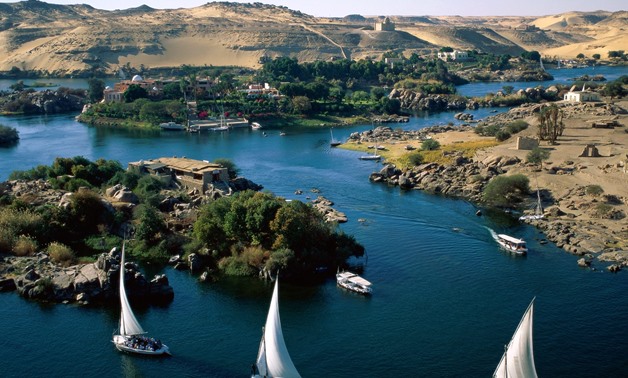
Aswan - cc via: commons.wikipedia.org
CAIRO – 5 August 2018: Governor of Aswan Magdy Hegazy stated that a new hygiene system is soon to be implemented in the city of Aswan, in south of Egypt. The new hygiene system consists mainly of developing a new water supply network, improving the city’s sewage and drainage infrastructure, with the aim to convert the city into a modern touristic hub.
Hegazy stated that the executive departments in the governorate are aiming to develop the city in an effort to solidify the beautiful city’s previous leading status among the numerous touristic hotspots around the world.
The governor expressed his previous statements during the convention held on Saturday with the governorate’s officials, where he urged officials working on the project to intensify their efforts in order to develop the city according to international touristic standards.
Aswan is just north of the Aswan Dams lying on the east bank of the Nile. The city is known for its hot desert climate that can reach up to 40 degrees Celsius during the summer. The climate drops and becomes moderate and beautiful during spring and winter. Many tourists from Europe, USA, Canada and Asia love to visit Aswan during the winter because of its magnificent moderate climate, escaping the freezing climates of their own homes.
The ancient city of Aswan is the portrayal of the strong Nubian culture that influences numerous areas south of Egypt.
Tourists in Aswan usually enjoy a Felucca ride on the Nile while they gather together and enjoy the beautiful natural scenery that surrounds.
Day tours are very common in Aswan. Philae Temple and Obelisk is a common day tour destination. The prices are usually affordable for most visitors and a beautiful day can be enjoyed with friends or family for a reasonable price.
Families, friends and solo travelers can enjoy a classy lunch while the boat cruises the Nile in Aswan in a very enjoyable and memorable experience.
Elephantine Island is one of Aswan’s major hotspots. Colorful mud-brick houses surround the area giving it a unique vibe. Aswan Museum lies in the southern end of the island.
 Nubian Villa in Elephantine Island - cc via en.wikipedia.org
Nubian Villa in Elephantine Island - cc via en.wikipedia.org
Ruins of Abu is Aswan’s most ancient settlement. It consists of the Old kingdom Temple of Khnum and the Temple of Satet.
Moreover, Aswan’s “Nilometer” lies near the ruins. It was used by ancient Egyptians to measure the Nile’s water level at a certain point during the year to further estimate the height of the annual flood and hence predict the result of their harvest beforehand.
The north part of the Island is also a must visit, especially the villages Koti and Siou. The houses in both villages are painted in colorful and very vibrant colors. Farmers in both villages attend to their farms until this day, which has been their family’s main source of income for generations.
The exotic property that was once owned by Lord Kitchener; Aswan Botanical Gardens can still be visited. Lord Kitchener transformed the place into a floral garden of exotic plants mixed from Asia and Africa.
 Aswan Botanical Garden - cc via: en.wikipedia.org
Aswan Botanical Garden - cc via: en.wikipedia.org
In addition to that, The Nubian Museum in Aswan is one of Egypt’s most significant monuments for history enthusiasts to visit. The museum portrays the ancient and modern Nubian culture.
Just outside of Aswan, 12 kilometers to be precise, lies Philae Temple, also known as Temple of Isis which is one of Egypt’s most beautiful monuments. The temple has a unique architecture and illustrates exquisite artistry. Even though not within the city’s boundaries, a visit to the temple is considered by most visitors for its beautiful design and the history it offers.
Moreover, Aswan’s Notherern Quarry hosts the notorious unfinished Obelisk. The stone is estimated to be a 41-meter-long and weighs 1,168 tons if completed. The reason for abandoning the stone is unclear until today, while many believe the stone was abandoned because of a huge crack in its body.
Aswan’s High Dam was one of Egypt’s most controversial projects in the country’s modern history that caused political havoc at the time of its completion during the early seventies. The works in building the dam begun in 1960 and took 11 years to be completed. The dam was President Gamal Abdel Nasser’s project and greatest achievement which was funded and supported by the Soviet Union during the 60’s.
Furthermore, the Monastery of St. Simon is also a great destination to visit in Aswan. It lies on the golden sand dunes of the Nile’s West Bank. The monastery is one of Egypt’s largest Coptic monasteries and was found in the 7th century.
In addition, Tombs of the Nobles is a beautiful series of rock tombs located at the West Bank’s cliffs. During the old and middle kingdoms in ancient Egypt, Elephantine Island’s governors, priests and other elites were buried there.
Last but not least, Kalabsha Temple, Aga Khan Mausoleum, Old Cataract Hotel and the Western Quarry (Gebal Simaan) are all unique places residing in the ancient and beautiful city of Aswan South of Egypt.
The government’s efforts to convert Aswan into a modern, exquisite and international touristic city is a step deeply anticipated by the Egyptians, especially those residing in south Egypt to improve and convert the region into a touristic destination which meets international touristic standards, hence providing the locals with new job opportunities and refresh the city’s economy.


Comments
Leave a Comment